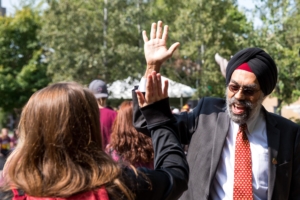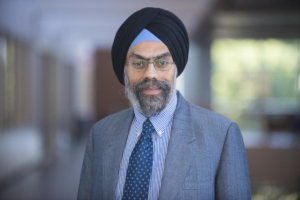
Raj Singh is the associate dean of the undergraduate program at the Carlson School of Management. Photo courtesy of the Carlson School of Management
Although the recent and tragic deaths of celebrity chef Anthony Bourdain and iconic fashion designer Kate Spade has shifted the issue of mental health to the forefront, the importance of the topic was — and remains — top of mind for Raj Singh, associate dean of the undergraduate program at the University of Minnesota’s Carlson School of Management. Five years ago, the school lost one of its students to suicide leaving Singh and the rest of the institution keenly tuned into more than just students’ starting salaries, but the state of their mental well-being while on campus.
The school has put different measures in place to assist in this area including adding the presence of a mental health counselor to speak with incoming students and parents about the importance of balance. More recently, the school experimented with professors normalizing these challenging topics by sharing some of their own encounters dealing with stress, anxiety, and the like.
Singh says that a recent student survey confirms that the school is doing the right thing putting measures in place. In the survey, in which 40% of the school’s population of 2,700 students responded, Singh shares, “It was concerning to see they feel a lot of stress, they don’t sleep well, they don’t think they have control of their lives. We’re taking this very seriously and putting a lot of resources into it.”
On the more traditional and a little more upbeat side of things, Singh says he’s energized by the work Carlson is doing to increase diversity within its student body and he’s encouraged by the relationships the school continues to build with its employer partners. In its most recent employment statistics report (2017), the school says graduates’ average starting salary was a little more than $56,600, nearly 98% of grads were placed within 90 days of graduation, and the top industries were accounting, consulting, and manufacturing.
In the wide-ranging, in-depth interview that follows, Singh speaks with Poets&Quants for Undergrads about engaging prospective students in underrepresented locales (as early as middle school), what Carlson is doing to meet the needs of today’s workforce, and more. Carlson is ranked 22nd on Poets&Quants’s most recent list of Best Undergraduate Business Programs.

“We have to do a very good job of teaching students how to be on the forefront of knowledge by using information to make good decisions,” says Carlson’s undergraduate dean Raj Singh. Photo courtesy of the Carlson School of Management
P&Q: You’ve been in academia a long time and been on the faculty at top business schools including Michigan’s Ross School of Business and WashU’s Olin Business School. How has business education changed from your perspective?
Singh: Sometimes it feels like a pendulum; it goes to one end to the other and then we go back. At one time, we were talking about business school being very applied then it was becoming abstract and more theory based. Now it’s coming back. Experiential learning is huge in every place. Technology is huge and using technology through teaching is big.
The other big thing I have noticed is there are a lot of efforts put into access for underrepresented students and first gen students. I think there’s more sensitivity toward this and we’re realizing for our economies to do well and businesses to do well, we need a more diverse student body. Another thing for business schools is employers are asking for it and putting a lot of pressure on us too. They’re saying to us, ‘You are producing our workforce and if you don’t give us the workforce we need, we can’t come knocking on your door all the time.’ Society and employers are concerned and these things are all lining up.
P&Q: What do these efforts look like at Carlson?
Singh: My friends in other programs are making efforts, but in our school we’ve realized that we need to do two things. One, make the place here much more inclusive and accessible to students who get in here and make them feel part of the community. We’ve brought in alumni from communities of color here more often, executives to mentor students who get here, and we’re finding ways of having more cross campus collaborations.
On the admissions front, we’re laser focused on these things. Last year, for instance, we increased the enrollment of black students in our incoming class. We went from nine to 14 incoming freshmen — a 50% increase. We had 22 incoming transfer students compared to eight last year. Thus, our incoming class of new students who are African-American went from 17 to 36 — a 100% increase. While the numbers are small, it still requires effort in doing that at the high school level. We also get a transfer class at the sophomore level and that’s where we’re able to get a lot more underrepresented from community colleges and so forth.
There are a lot of concentrated efforts, but we realize it’s not enough so we’re starting to go in at the middle school level. We’re partnering with a program that has summer programs for middle schools in very urban and underrepresented middle schools. For two weeks this July, I’m going to teach a class on what is finance to fifth, sixth, and seventh graders. Not all of them will be ready to be admitted in six or seven years, but we want to start getting in front of them now.
If we touch 150 students and 20 of them want to come, we‘re building the relationship early. For us, that’s more important than getting our ACT score up by five points.
We’re spending a lot of effort. Minnesota is a very white state so for us it’s really important. Not just business students, but I think it’s extremely important for Minnesota students to know and learn how to operate in a multicultural environment.
P&Q: How have students changed over the years?
Singh: You see the changes happen slowly. From day-to-day they’re small, but go back 20 years and there’s something that stands out. I think today’s students are more diverse in their needs. I see some students who are very, very purpose-driven, looking for meaning in life and in their profession. Then I meet some who are totally on the other extreme. They only want to know ‘How do I get in investment banking and how do I get to $200,000 in five years?’
They also have a consumer mindset. They’re saying to us, ‘We’re paying this tuition, we’re spending this time, this is what we need.’ I’ve heard other business school deans talk about this.
Also, they’re not used to failing anymore. They just come in and most of them have done very well in high school and because our admissions process becomes so competitive, they have not failed and not learned how to fall and get up again. That is something that’s so important in life. Resilience is something we have to have colleges work on more.
The other thing that’s changed is they have so much information at their fingertips, on their phones, and on their computers. Twenty years back, a lot of teaching used to be giving them information. Today, we cannot survive on giving them information that’s already out there and easily available. We have to do a very good job of teaching them how to be on the forefront of knowledge by using information to make good decisions. That’s something that has slowly changed over time. That’s where we as a school have to add value for their time and their effort that they spend with us.











Questions about this article? Email us or leave a comment below.